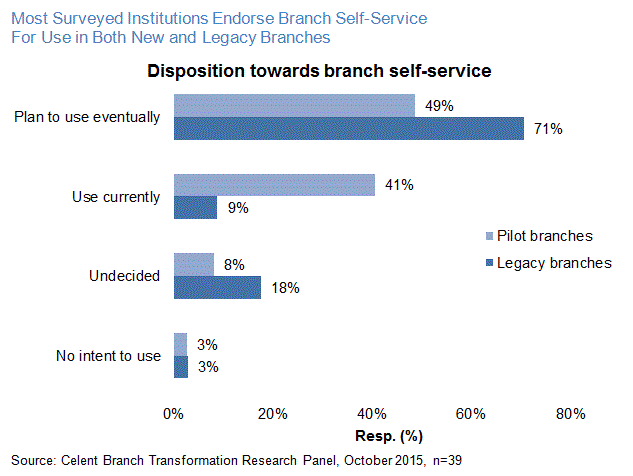The Branch Self-Service Conundrum: How US Banks Are Navigating the Options
Celent Branch Transformation Panel Series Part 3
Abstract
Celent expects broad deployments of in-person assisted self-service devices as alternatives to teller pods in new branch designs.

In the report, The Branch Self-Service Conundrum: How US Banks are Navigating the Options, Celent offers an analysis of its third Branch Transformation Research Panel survey, which examines institutions’ disposition toward branch self-service as an alternative to teller transactions.
A June 2015 survey found that two-thirds of institutions felt that self-service devices not involving video tellers would be a “likely” or “extremely likely” component of future branch designs. A smaller percentage (46%) felt similarly about video teller machines. The October 2015 survey explores the topic further, finding the panel endorsing the use of branch self-service both in legacy branches and new branch designs.

“At this early stage in branch channel transformation, assisted self-service certainly looks like it’s destined to become a common fixture in new branch designs,” says Bob Meara, a senior analyst with Celent's Banking practice and coauthor of the report. “While banks convey a welcoming attitude toward self-service inside the branch, this won’t necessarily translate into widespread deployments. Lots of testing and experimentation need to be done first.”
Several additional insights from the research include:
- The panel exhibits a strong disposition toward branch self-service, with appetite for both in-person (tablet-enabled) and remote (video-enabled) assistance.
- Video tellers will likely be used stand-alone as well as alongside in-person tellers to support a variety of use cases. If a video infrastructure is to be built, it should be fully leveraged. This means using video for both teller assist and SME engagement.
- Institutions will deploy self-service devices as an alternative to tellers. Tellers won’t disappear with the growth of branch self-service, but traditional teller stations will be largely replaced by a fewer number of “teller pods.”
- Cash recycling will move from usage in a minority of cash-heavy branches to the de facto standard for branch currency management.
- Branch channel transformation will take most institutions two to three years to figure out and longer to implement broadly. By then, it will be time to adjust the delivery model again.
After a recap of key findings from previous surveys, the report begins with an analysis of measures institutions are taking to favorably influence self-service channel adoption. We then explore the use of branch self-service devices and banks’ disposition toward the competing mechanisms for providing staff assistance; in-person (tablet) and video. Celent then examines the future role of the teller as more transactions migrate to self-service. Will banks completely replace teller stations with self-service devices? We then look at how institutions plan to manage currency in increasingly automated and lightly staffed branches. What is the future for teller cash recyclers that have gained such popularity of late? The report concludes with recommendations for dealing with uncertainty before, during, and following the deployment of pilot designs.

